Snails and slugs are one of the most common pests in the garden, and the traditional pesticide treatment for them is particularly nasty. If you are transitioning to an organic garden, treating snails and slugs differently is an easy (and still highly effective) change that will have a great impact on your family’s health and safety.
Why the usual snail bait is so bad:
You may be thinking that traditional snail bait can’t be that scary, because everyone uses it. Not true.
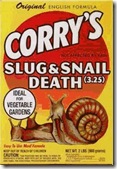 In California, snail bait/ metaldehyde is the most common cause of poisoning in dogs. It will affect any animal that ingests enough of it (yes, humans too), and “enough of it” is a very small amount – only a teaspoon per ten pounds of body weight. Fido can lap up enough to kill him in one or two licks, and since many of the baits are combined with wheat or molasses to attract snails, it even smells good to him.
In California, snail bait/ metaldehyde is the most common cause of poisoning in dogs. It will affect any animal that ingests enough of it (yes, humans too), and “enough of it” is a very small amount – only a teaspoon per ten pounds of body weight. Fido can lap up enough to kill him in one or two licks, and since many of the baits are combined with wheat or molasses to attract snails, it even smells good to him.
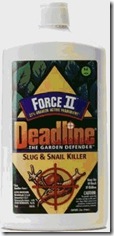 Liquid bait, like Deadline, is no better – a cat can be poisoned easily through stepping on it and then grooming his paws later.
Liquid bait, like Deadline, is no better – a cat can be poisoned easily through stepping on it and then grooming his paws later.
If the harm to your own or neighboring pets and children (and wild birds) isn’t enough to convince you, consider this: traditional metaldehyde snail bait is most toxic through inhalation. Most people use a form that looks like sawdust and blows around easily. Do you really want to be applying something toxic in the manner most likely to cause you poisoning?
A safe and simple organic alternative to kill snails:
Fear not. Banning metaldehyde-based/ traditional snail and slug bait from your garden needn’t relegate you to a life of setting out beer and retrieving drunken snails every morning.
Iron phosphate bait, also sold under the names Sluggo, Worry-Free, and Escar-Go, is an extremely effective organic bait which has ingredients that are generally regarded as safe for food use by the EPA (not that you’d want to eat it – you can overdose on iron, you know!).
The stuff works great! Many people think that it isn’t effective because they don’t see the piles of dead snails right where they put the bait, but that’s because iron phosphate works differently. After the snail or slug eats the bait, they crawl away and die a few days later, but they stop eating your plants immediately.
Organic snail bait is actually more effective in our rainy, damp climate than the traditional bait is, because it doesn’t dissolve in the rain as fast as traditional baits do.
Iron phosphate is non-toxic to pets and wildlife. One caveat, of course, is that you should sprinkle the bait out and never set it in piles that would be easily ingested. Just like your kids shouldn’t down a bottle of iron-containing vitamins, pets shouldn’t eat a pile of iron phosphate. But sprinkling is the proper method for using it anyway, since when it’s placed in piles it can mold.
I’ve tested this in the gardens I maintain for years, and it’s proven every bit as effective as the nasty stuff and it is even easier to use. You can find great prices on Sluggo at Amazon.
Some tips to help you control snails and slugs using any kind of bait, organic or traditional:
First, try to keep areas clear of hiding places for snails and their eggs. Leaf litter and debris, large weeds popping up in between your other plants, and old overturned pots can provide shady, moist shelter to snails and slugs.
Next, try to anticipate problems and put out bait before they are eating your plants. In veggie beds for example, if you set out bait before your seedlings germinate or before you put out delicate starts, the snails and slugs will be more likely to eat the bait. If you wait until your larger plants are covered in baby snails, they may not come off their food source long enough to eat the bait. This is true for organic or traditional bait.
If you remember, set out bait after a rainshower, as they’re more likely to be active and eating then.
Fall is also a great time to set out bait, since you can kill them before they lay eggs. Bait in early fall to prevent egg-laying, then late fall to try to kill any that have just hatched.
Non-bait solutions to slugs and snails:
There are other alternatives to using either organic or traditional bait. They aren’t perfect, but they deserve a mention:
Get yourself some backyard chickens or ducks! My ladies eat all my snails with great crunching vigor. They’re less keen on slugs, but they’ll eat them, too.
Of course, chickens present other issues – I’ve had to fence off my veggie patch so they don’t eat my chard and lettuce down to nubs – but any mollusk who dares step outside the veggie beds gets chomped quickly.
(I have read that the organic snail bait doesn’t hurt chickens who have eaten it as far as the chicken owners could tell, but to be on the safe side, I’d only use it where the chickens don’t roam – you won’t need bait in the areas they go!)
Plant things that the snails don’t care for. This eliminates leafy green veggies, Dahlias, Hostas, Artichokes, and a number of small flowering annuals and perennials.
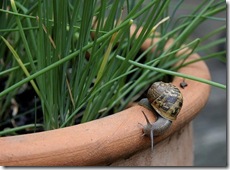 But that still leaves a wide variety of ornamentals and edibles that they rarely go after – most woody shrubs, heathers, ornamental grasses, conifers, larger tomato and squash starts, blueberries, potatoes, culinary herbs, etc (the picture at left is a snail avoiding eating Chives).
But that still leaves a wide variety of ornamentals and edibles that they rarely go after – most woody shrubs, heathers, ornamental grasses, conifers, larger tomato and squash starts, blueberries, potatoes, culinary herbs, etc (the picture at left is a snail avoiding eating Chives).
If you live in certain areas of (mostly southern) California or Texas, you may release predatory decollate snails which will eat your regular garden snails. This doesn’t work for me here in Humboldt County, but this link will tell you which counties are legal to ship them to.
Copper tape is another option, and it’s only occasionally effective. I’ve seen some snails just walk over it like it’s nothing, though some people do find it effective.
If you want to try it, it’s best used around veggie beds or around pots. You need to form a complete barrier all the way around the plants you are protecting, and keep leaves from draping or trailing on top of the tape, as that can form a bridge for the snails and slugs to go over.
Keep the copper tape clean by wiping it down periodically.
There are other controls for snails and slugs, but I’d classify them in the “doesn’t work well enough for all the dashed trouble you take doing it”, or “has other side effects that aren’t fantastic” categories:
Wood ashes, diatomaceous earth, and pine needles can act as an uncomfortable surface for them to walk on, cutting their undersides.
Diatomaceous earth needs to be reapplied often and can cut the inside of your lungs in the same way it cuts the snails, so I veer away from that. Wood ashes make your soil alkaline, so you probably don’t want to use that control often, and pine needles make your soil more acid, which again isn’t great long-term unless you’re protecting acid-loving plants.
You can set out rolled-up newspapers or small pots tipped sideways to provide shade to the snails during the day, and then come out and dispose of the snails each day. I don’t have that strong of a stomach or that much time, do you?
A Way to Garden suggests encouraging snakes to roam in your garden, because many snakes eat slugs. She has a great tip about walking your garden with stompy steps before mowing, to allow snakes to hide. Apparently snakes can’t hear the mower – but the vibration of your footsteps will scare them away.
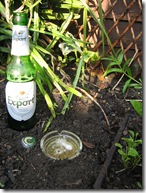 Setting out beer in bowls is the college student’s choice since they can always find the flat dregs of a beer to dump out, but this ignores the fact that most college students are busy enough that they won’t go out and smash any snails they catch this way. At best, you catch a few snails and have a stinky bowl in the garden, at worst, you feed the snails and beef them up for their next round against your plants.
Setting out beer in bowls is the college student’s choice since they can always find the flat dregs of a beer to dump out, but this ignores the fact that most college students are busy enough that they won’t go out and smash any snails they catch this way. At best, you catch a few snails and have a stinky bowl in the garden, at worst, you feed the snails and beef them up for their next round against your plants.
And in the really disgusting category of control, you have salting. The under-10 crowd will love this – you’ve probably seen how dramatically snails and slugs foam up when salted. But plants don’t love growing in salty soil, so I’d be wary of letting the little ones loose with a salt shaker on my garden. It’d keep them busy, though, wouldn’t it?
What’s worked, or not worked, for you?
Are there any plants you think of as snail candy or snail hotels? How do you control snails in your garden? Click below to leave a comment and tell me what you think!
Resources:
Read about organic weed control
How to kill dandelions in lawn using vinegar injection
Read reviews on Sluggo at Amazon

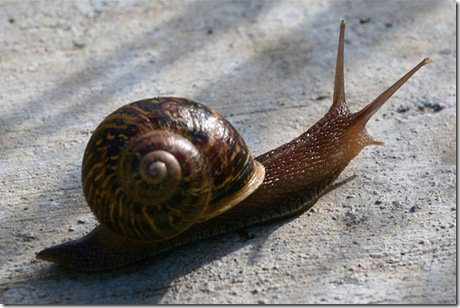
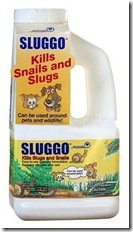
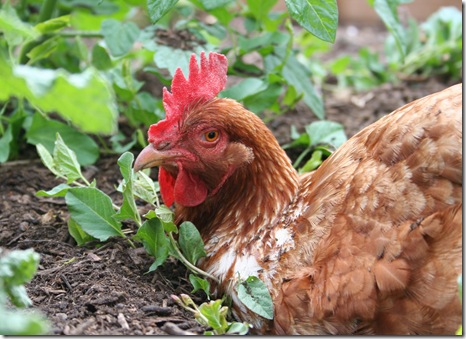
50 responses to “Organic Snail and Slug Control: How to Kill Snails and Slugs Naturally”
Like you, I really don’t like the metaldehyde based slug pellets for all the reasons you’ve stated.
Living in the UK I’m fortunate enough to have access to a nematode based product (http://www.nemaslug.org.uk) that uses a nematode that occurs naturally in the UK to kill the slugs.
Last year my cauliflowers got nearly destroyed by slugs, this year I have used nemaslug and the results are looking good. Although so far the weather has been very hot and dry (for the UK) and therefore not good slug weather.
Wow, what a great comment! I’m going to see if there are nematodes here we can buy. Thanks for the tip!
Apparently chickens also like boxelder bugs! I’m lucky not to have snails but admit I do find them so cute. Related, but unrelated, is one of my favorite gardening quotes: “You might be a normal gardener when you can crush a Japanese beetle between your bare fingertips. You might be a master gardener if you love the sound it makes when you do.” -Tracey Knack, Master Gardener Coordinator, Isabella County, Michigan 🙂
Monica the Garden Faerie’s last blog post..Chicago Spring Fling
I bought some iron phosphate bait after you suggested it, put it down, and it works really really well. I sprinkled it around my seedlings and there is not a slug in sight.
They got eaten by flea beetles instead. :-/ (actually, that wasn’t too bad – all of them survived, it just means that the rocket we grew has holes in it, and tastes extra peppery)
I’ve got a little metaldehyde left from last season, but after that’s gone I’m making the switch permanently. I’ve got my parents trying it out as well. Thanks for the tip!
I must say though, both nematodes and predatory snails definitely appeal to my inner 6-year-old-boy.
For Christmas last year we got one of those automatic salt grinders that has a little flashlight on the bottom which switches on when you grind the salt. I spent a few fun evenings lighting up slugs and watching them foam before deciding it probably wasn’t doing the soil any good 🙂
Iain Gray’s last blog post..90 Minute Marketing Plan Seminar – June
Monica, I love that quote! 🙂
Iain, oh my gosh, that flashlight salt grinder sounds awesome. I would have loved that when I was a small kid getting paid by the slug. That’s hilarious.
I checked on nematodes and that looks like a UK thing as far as I can tell. So Iain, that might be an option for you! They sound wonderful, like you apply them once and then they’re just there killing snails for you for a long time…
Hi Gen
We got to the country house late Friday night and because we are crazy people from the city we were walking around the garden with a flashlight checking things out . And YUCK there were slugs all over my blue eyed grass (Sisyrinchium bellum). SLUGGO sounds like the answer. Great post. Thx Missy!!
Iona’s last blog post..Taschen Chic
A couple years ago I toured a hosta garden as part of our local garden walk. The gardener, a former president of the regional hosta association (or something like that) had no slug damage at all, on about a three-acre property almost entirely planted with hostas. He said his secret is an ammonia solution. Diluted somewhere between 4-1 (water to ammonia) to 20-1, the ammonia solution is poured over hostas and on the ground around them from the time the eyes are just shooting up. It sounded really scary, but this guy had a 6-foot wide, 5-foot tall hosta on the corner of his house so who am I to question? I’ve been doing it for two years now, and I do feel that last year really helped. I try to do it after it rains, when slugs are out and about. I have seen it get a few slugs … very similar to the salt effect.
Sluggo’s been on my list to try, though. They sent some samples for our plant sale (I missed out on them unfortunately), but my sister-in-law’s lab ate a small packet of it and was fine, which says a lot about Sluggo and less about the intelligence of the average lab.
Erin’s last blog post..Spring has really come
are you sure the ammonia solutions is actually killing the slugs and snails or just generating lush plant growth that the slugs and snails are avoiding or the damage they cause goes unnoticed? generally speaking they won’t eat healthy plants, so I’ve heard, but they sure seem to like eating seedlings, which is my biggest frustration!
Iona, it sounds like you are crazy country people at heart!
Erin, wow, thanks for that info about ammonia. That is truly excellent information and I’m going to try that out. I’m really glad to hear your sister-in-law’s lab is OK after the encounter with sluggo. Thank goodness. I’m glad to hear it really is pet-safe on the whole.
Genevieve,
I typically do not have an issue with slugs in my garden but it has been raining here in southwestern CT for the past 5 days and I just walked around my garden and my hostas have a lot of slug damage. I will have to try Sluggo and see if that stops them, especially since there’s more rain in the forecast next week. Between the deer and the slugs I am beginning to wonder why I bother with hosta at all!
Debbie R’s last blog post..Welcome To My Test Garden
I could not find any salt in my garden shed, so i tried citric acid – worked great – does anyone have any experience with Citric acid in the garden?
i go out on the new moon – it seems they hatch at that time – and look for tiny ones – they can do a lot of damage – they can be very tiny.
go early, take your coffee and enjoy the morning and the hunting experience…. the dew on the edge of the delicate leaf.
Debbie, I hope you have success with Sluggo! I’m bummed out that deer eat your Hostas. They don’t usually pester them here in Humboldt.
Michele, thank you so much for the excellent info! I’ve had success with citric acid sprays on weeds, but never tried CA on snails or slugs. Great tip.
Great tip on the new moon hatching time, too. You are providing me an awesome education here!
Genevieve’s last blog post..Organic Gardening 101: How to Amend Soil
I don’t know if the ammonia solution that Erin mentioned is actually killing slugs, but I hope so. However, it is definitely supplying the hostas with good old ammonium, which is one of the two nitrogen compounds that plants can utilize. I dump my used mop water (non-sudsing ammonia) around my nitrogen-hungry plants.
Have you noticed if Sluggo works on those nasty big brown slugs we get in Hum Co? The snails are obvious, but I haven’t yet seen a slug corpse.
Hi Lauraven! I’ve since done a bit of looking about the internet on the ammonia thing, and it is recommended by a lot of Hosta lovers! I did read somewhere that it changed the ph of the soil over a 2-3 year period, so I’d probably use ammonia one year, sluggo the next, (or rotate which areas of the garden you dump your mop water) to give the soil time to get back in balance.
I have not found any dead slugs either (I suspect they are better hiders and crawl away to die where they aren’t found – sluggo does take days to actually kill the slugs after they stop eating), but I have used sluggo in gardens where those slugs are the main problem and noticed an immediate turnaround, so yes, I am 99% sure it does work on those guys too.
Lots of good info here! I’m intrigued by nematodes and ammonia – and Monica’s quote! Also the amazing flashlight/salt grinder, something my sister would have deeply enjoyed in her childhood (she once stepped, barefoot, on a slug: the scream rang out for miles).
A market gardener friend in the Pacific NW agrees that copper strips are useless. Friends report that, unfortunately, slugs have good taste in beer: at least they caught more slugs when they used the good stuff. Microbreweries take note: this could be a new market. Although it might be a sluggish one.
.-= Pomona Belvedere´s last blog ..Salvia sclarea: Clary Sage =-.
[…] This ‘Gold Lace Black’ Primrose has such a lovely contrast in a part-shade container or garden bed. They look great in drifts in a woodland setting if you can afford a bunch. Just protect them from snails! […]
[…] bought some Sluggo to protect my hostas next spring. I became intrigued by Suggo after reading Gen’s review and had to get some to try in my own garden. If spending your money on tools that actually […]
[…] bought some Sluggo to protect my hostas next spring. I became intrigued by Suggo after reading Gen’s review and had to get some to try in my own garden. If spending your money on tools that actually […]
Some fantastic ideas there. I never realised that chickens would eat snails and slugs. I think could be a good option, especially if I can get some fresh eggs out of it. I hate using slug pellets because I always fear for the birds that eat the slugs so normally use some beer although I don’t find that it works that well . Maybe I should change the type of beer!!
I was looking for an nature friendly product to kill slugs and snails (kind of an oxymoron huh?). Most of the organic products I’ve tried seem marginal at best. I want an organic product. I found this one product doing a web search. It popped up at http://www.snail-n-slugaway.com. I see their product advertised on their website, but I don’t see a way to purchase it from a retailer or on-line. It looks pretty promising, but I can’t seem to find someone who actually is selling it or knows much about it. It looks like it could be an organic way to effectively deal with snails and slugs; it says its and an ovicide too. That is quite appealing to me because snails are laying 20 to 100 eggs a day so with a bait they come to and then don’t dye for a few days, thus leaving a legacy of 60 to 300 follow up snails after they eat the bait. So my question is, do you know anything about this product or has anyone tried it. I would really like to test it out, but I can’t find any place to buy it. Any help you could give me with this would be very much appreciated. Thanks.
Never heard of it, IB, but I’m guessing snails and slugs aren’t producing new eggs while dying of iron poisoning. They aren’t eating, either, after they eat the iron phosphate bait.
It is certainly neat that you can spray it directly on very susceptible plants, but I wouldn’t rely on it as the only control, because dousing plants and soil with it sounds expensive and time-consuming. I’d just use that on new seedlings or very tasty plants and use iron phosphate elsewhere.
I’m annoyed with their website for claiming that other organic snail bait harms earthworms and is unsafe for pets and kids. That’s patently untrue.
If you want to try it, I’d call the company and see where they suggest buying it. Good luck!
Great post! Here’s a humorous little post on some rather drastic ways of slug control, some of which are similar to your suggestions 🙂 Happy gardening!
coffee grounds around your plants kills the snails
[…] Learn to control snails organically […]
I used salt in my first garden, years ago, with enthusiasm. It killed the snails and poisoned the soil for the plants, especially the corn — I got tiny stunted two foot tall corn plants that still tried to make ears, little round ones like the bellies of starving children. It was especially embarrassing because this was in a community garden and other people had corn six feet tall, ten feet tall…yeesh. Learned a lesson there!
Instead of beer, I use cans buried 3/4 of the way in my garden and half-filled with a mixture of fruit juice and water. I use these to get beetles in the strawberry beds and it works great for that, and actually gets a lot of snails too.
Oh Rachel, that’s a great cautionary tale – I mean, not so great on the plants but good for us to remember. That’s a great tip about fruit juice, too. Thanks!
Rachel,
What kind of fruit juice?
Epsom salt works about as well as table salt (not very well)–I’m not sure either actually kills snails but dries them out & irritates them and deters them perhaps. Epsom salt at least is actually benefitial for plants and the soil, but it washes away easily so if leaving on the ground make sure it’s dry if you want to deter snails for awhile. I’m wanting to try decollate snails (they eat brown snails) but I’m just barely north of the counties in California able to have them and haven’t found a site that will ship to Stanislaus County, Calif. If anyone knows of a site or seller who may ignore the restrictions (which don’t make much sense considering Madera and Fresno counties can have them just south of me) let me know. Thanks
I have slugs and they ate all my zinnas that I planted from seed, I had dill come up from last year next to my flowers and in the early morning when dew is on I go out and the dill is hanging full of slugs, so I pick them off and it seems the dill is attracting them off the other stuff. has anyone experience dill ??
[…] that are hazardous to pets and kids. North Coast Gardening does a nice job of outlining different slug/snail controls and their pros and cons. Care to add a solution of your […]
A few years ago I started paying neighborhood kids $.50 per toad they would bring me, even though I was not absolutely certain of my source info. The toads little by little have reduced my slug population up through this year. I leave water out several places for the toads since our southern Kansas summers are usually dry and hot. They bathe/soak in the water as well. And, the water needs to be changed every few days to discourage mosquitoes. This past summer has been incredibly hot and dry and I’m a little concerned about toad survival. Turning over some stones this week was evidence slugs survived. Get your quarters out!
I’ve heard that copper collars keeps slugs away. Have you heard that? Is it true?
Hello.
I don’t use any chemicals in my garden because I have a small dog and a cat that love to munch plants and dirt.
The salt was good, but if I didn’t keep up on it then I was soon overrun.
I loved the beer method!! Except for the ugly pile of slugs, the fact the my containers would get rusty and ugly, and the rain would dilute the beer. To counter these issues and keep the best solution i have found in play, I invented the Garden Dink. It’s only available on Etsy. Each on is hand made in Nehalem.
Check it out.
https://www.etsy.com/listing/98985483/decorative-slug-trap?ref=sr_gallery_1&ga_search_query=slug+trap&ga_view_type=gallery&ga_ship_to=US&ga_min=0&ga_max=0&ga_search_type=handmade
If this link doesn’t work, you can go to Etsy.com and search for slug traps.
Keep fighting!!
y.
i have heard the you can make a brine of salt and vinegar in a bucket, put a rope in it to soak it up and place it in a raised bed around the top edge. slugs wont go over the rope because of the brine… Not sure if it works. might give it a try. of course it dosent kill the slugs that are already in the garden.
[…] This website also has great tips for controlling slugs in the garden. It includes natural solutions such as planting deterrents such as chives. I’ve also heard that sprinkling crushed egg shells around the plants can be effective. Share this:TwitterFacebookLike this:LikeBe the first to like this. […]
I have been told that a gravel strip 24 inches wide around the outside of the vegetable plot will not be crossed by slugs. Anybody any experience of this?
I have banana slugs here, which are totally undaunted by a 2′ strip of gravel. That may help with teeny tiny slugs but I wouldn’t put much faith in that, personally. I mean, they can live their whole lifecycles within the veggie bed once one or two get in, so while it might help, it won’t be the only solution.
I adore flowers and the garden, but i will NEVER kill Snails, ‘ALL the creatures of the forest are mine’, It doesn’t say’ SOME of the creatures’, it says ALL. I have a collection of old saucers, i use them just to put some food out for the Snails, near all my plants, because i’m sorry but i’m not killing them for anything, with pellets etc. I fill the saucers with huge cabbage leaves, slices of Apples, Banana, Cucumber, (Snails love all these things), i put it out on the saucer usually just as it’s getting dark, the saucer ends up full of Snails happily munching away and they leave your plants alone. Believe me, Snails eat plants as a last resort, they LOVE apples slices and cabbage leaves etc (we all buy too many apples, bananas etc and never use all the cucumber we buy). I knew a couple who adored their garden, they never killed a thing in it, not even an Ant, and their garden was the most beautiful garden i have ever seen, because they left it to nature.
I admire your spirit and thank you for your excellent tip, Jojo!
Genevieve, Thank you for your kind reply, i just don’t like anything living killed, and you get joy out of Snails, often we go out just before bed and see loads of Snails eating the saucers full of apple, Banana, cucumber slices, and in the quiet of the night you can hear them munching! Snails have the beautiful spiral shells, some have a lovely yellow, or mint humbug pattern on their shell. too many living things are destroyed, (including our fellow human beings), I’m not a ‘church goer’, but i believe Our Creator ,(God), who is not a person, ( but a spiritual being of ALL life and love ), created everything living. I’d rather feed the Snails, if you haven’t got saucers use anything such a a square plastic lid of square piece of wood, anything to put the food on. EVERYTHING has it’s place in the world, and we shouldn’t go round killing things, just because they don’t suit us being there.
I respect that opinion. I certainly don’t take joy in killing them. Another perspective: The garden snails that are a problem here were originally imported as a food item from Europe. They don’t belong in our ecosystem. The snails that are native to the Northwest are not at all destructive of gardens. Of course, you could say the same about honeybees, and we’d certainly be in trouble if they all died out. It’s a complex issue. I’m glad to have another point of view added to it.
I agree with Jojo. The first time I used slug bait in my garden, I felt heartsick the next morning to see the cruelty I consciously imposed on those poor, unsuspecting creatures. I decided then and there to no longer plant anything in my beds or garden that slugs or snails eat, and if you check, there are many options available. Doing so has given me less work and a good conscience.
Crushed egg shells around your plants keep snails and slugs at bay.
Copper sulphate not only kill snails and slugs, but also the eggs. Too much, however can also cause damage to some plants.
just read an article about the dangers of the so-called “safe” snail pellets like Sluggo – that was what I googled – “sluggo and chickens” because we have chickens and snails but the chickens are in bed when the snails come out…. anyway the article’s writer did some research about HOW sluggo works – why does the iron phosphate kill the snails – and discovered that the product also contains EDTA which is what makes the iron phosphate available to the body – ANY body – and thus causes iron poisoning (of slugs, snails, dogs, chickens, potentially any living thing that eats too much of it). Don’t take my word for it, google as I did. So I pass this on as a word of caution, and I’m going to be really careful where I put my sluggo compared to where my one chicken who always escapes the run, likes to go in my garden.
Thank you for this tip, Virginia. I have read reports of chickens and dogs eating it without harm but you can’t be too safe when using any pesticide, organic or not. It’s obviously not worth hurting a beloved pet friend over snails!
There is an organic way to kill snails, worms.Use tea seed meal in the garden, rice farm, soil, it will work within 7 days.
tea seed meal is the residue of tea seed after oil extraction. Here in China we use tea seed oil to cook. and the residue which is called tea seed meal is widely used for rice farm, shrimp farm, garden, golf course, sport turf, etc. It is approved by USA golf association for worms control.
Tea seed meal is 100% organic, and not toxic to human being and plants, instead, it will help growing of the plants, because it is rich in protein, fiber, starch and sugar.
Hi Ashley, where can I get tea seed pellets?? I can not find any place in the US
thank you
I need help getting rid of snails in my aquarium. They must have come in on the live plants that I have and they are multiplying. My aquarium is for keeping newts (amphibians) who are carnivorous though not interested in eating snails.
Suggestions, anyone?
Snails carry Lung Worms to My Goats ….May be Slugs do also. ….I plant Deer Browse seeds for my Goats and the Snails and Slugs eat the seeds….My Property is divided into very small Plots so that I can protect the seeds till the plants grow big enough for the goats to eat…In those Plots I have put sticky mouse catching pads with covers to catch the chipmunks that feast on the seeds …. I see the pads are covered with snail shells when I go to check them……Win Win for me.
In my garden, the slugs have totally stripped my Asters, nearly 2 days after transplanting. They have also taken out a large half row of Sugar Snap Peas. They have ate the leaves of the watermelon radish, the leaves of the beets, and also parsley. At first, the Lamium was unharmed, and then today I noticed baby slugs inside them after investigating small holes in the leaves. They have also stripped a few Dwarf Marigolds. My tomatoes, spinach, zucchini, red rubin basil, and thyme are all unharmed.
These slugs are the bane of my existence. It is so frustrating, as my vegetable garden is how I feed myself and son affordably — and we have lost so, so, so much this year. I do grow organically, and think I will order the Sluggo for the fall and for next spring. Thank you so much for this page – it is incredibly helpful.